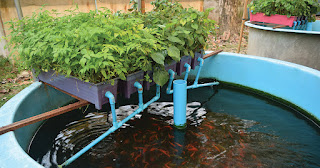Eco-Friendly Aquaponics for Sustainable Living
Aquaponics, a symbiotic integration of aquaculture (raising aquatic animals) and hydroponics (growing plants without soil), presents a compelling solution for sustainable food production. This innovative approach offers a pathway towards environmentally responsible living, minimizing resource consumption and maximizing yield. This article explores the principles of eco-friendly aquaponics, its advantages, challenges, and the steps involved in establishing a successful system.
Understanding the Symbiotic Relationship
The core principle of aquaponics lies in the symbiotic relationship between fish and plants. Fish waste, rich in ammonia, is a byproduct of their metabolism. This ammonia is toxic to fish, but beneficial bacteria, housed in a biofilter within the system, convert it into nitrites and then nitrates. These nitrates, in turn, serve as essential nutrients for plant growth. Plants absorb these nitrates from the water, effectively cleaning the water for the fish, creating a closed-loop system of remarkable efficiency.
The Nitrogen Cycle: The Heart of Aquaponics
The nitrogen cycle is the cornerstone of any successful aquaponic system. This cyclical process can be summarized as follows:
- Ammonia (NH3) Production: Fish excrete ammonia, a highly toxic compound.
- Nitrification: Beneficial nitrifying bacteria (Nitrosomonas and Nitrobacter) convert ammonia first into nitrites (NO2-), which are also toxic, and then into nitrates (NO3-), a less toxic and readily usable form of nitrogen for plants.
- Nitrate Uptake: Plants absorb nitrates from the water column, utilizing them for growth and development.
- Water Purification: The removal of nitrates by plants purifies the water, ensuring a healthy environment for the fish.
Maintaining the balance of this nitrogen cycle is crucial. An imbalance can lead to fish mortality or stunted plant growth. Regular water testing to monitor ammonia, nitrite, and nitrate levels is paramount.
Types of Aquaponic Systems
Several aquaponic systems cater to varying needs and scales. The choice of system depends on factors such as available space, budget, and desired output.
Media Bed Systems:
These systems utilize a bed filled with gravel, clay pebbles, or other inert media to support plant roots. Water from the fish tank is pumped into the media bed, allowing plant roots to absorb nutrients. This is a popular choice for beginners due to its relative simplicity.
Deep Water Culture (DWC) Systems:
DWC systems suspend plant roots directly in nutrient-rich water. This method allows for rapid plant growth and high yields, but requires careful monitoring to prevent oxygen depletion.
Nutrient Film Technique (NFT) Systems:
In NFT systems, a thin film of nutrient-rich water flows continuously over the roots of plants. This system is highly efficient, but requires precise control of water flow and temperature.
Eco-Friendly Considerations in Aquaponic Design
The inherent sustainability of aquaponics can be further enhanced through thoughtful design and operation. Several eco-friendly considerations should be prioritized:
Water Conservation:
Aquaponics inherently conserves water compared to traditional agriculture. However, minimizing water loss through evaporation and leakage is crucial. Proper system sealing and the use of covers can significantly reduce evaporation.
Energy Efficiency:
The energy consumption of pumps and aeration systems can be a significant factor. Choosing energy-efficient equipment and optimizing system design can reduce energy consumption and environmental impact. Solar-powered pumps offer a highly sustainable option.
Sustainable Materials:
Utilizing recycled or reclaimed materials for system construction is environmentally responsible. Examples include repurposed containers, pallets, and other readily available materials. The selection of non-toxic, biodegradable materials for media beds is also important.
Pest and Disease Management:
Integrated pest management strategies are essential in aquaponics to avoid the use of harmful chemicals. Natural predators and biological controls can help maintain a healthy system. Good hygiene practices and proactive monitoring can minimize disease outbreaks.
Challenges and Considerations
While aquaponics offers numerous advantages, certain challenges require attention:
System Balancing:
Maintaining the delicate balance between fish and plant populations is crucial. Overstocking the fish tank or an imbalance in the nitrogen cycle can lead to system failure.
Disease Management:
Fish and plants can be susceptible to diseases. Regular monitoring, proactive disease prevention, and appropriate treatments are necessary.
Initial Investment:
Setting up an aquaponic system requires an initial investment in equipment and materials. However, long-term cost savings in water, fertilizer, and pest control often outweigh the initial expense.
Building Your Own Eco-Friendly Aquaponic System
Constructing an aquaponic system requires careful planning and execution. The following steps outline a basic approach:
1. System Design and Planning:
Decide on the type of system, size, and species of fish and plants.
2. Materials Procurement:
Gather all necessary materials, including tanks, pumps, pipes, media, and plants.
3. System Assembly:
Construct the system, ensuring proper plumbing and water flow.
4. System Cycling:
Allow the system to cycle for several weeks before introducing fish to establish beneficial bacteria colonies.
5. Fish and Plant Introduction:
Introduce fish and plants gradually, monitoring their health and growth.
6. Ongoing Monitoring and Maintenance:
Regularly monitor water parameters, clean the system, and address any imbalances or issues.
Aquaponics offers a viable pathway to sustainable living, combining food production with environmental responsibility. By carefully considering the eco-friendly aspects of system design and operation, individuals can contribute to a more sustainable future while enjoying the rewards of fresh, homegrown food.

